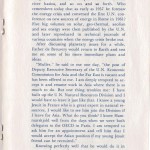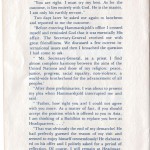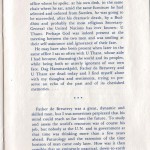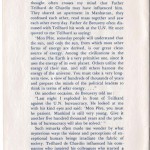FATHER DE BREUVERY AND TEILHARD by Robert Muller – Meditation at UN Suplem – 1977-mar
Filed under Tributes and Expressions of appreciationFATHER DE BREUVERY AND TEILHARD
by Robert Muller

Cover photo of Father Emmanuel de Breuvery by United Nations
Printed by : Agni Press, 84-47 Parsons Blvd., Jamaica, N.Y. 11432
March, 1977
Mr. Muller is presently Director and Deputy to the Under-Secretary-General of the United Nations Office for Inter-Agency Affairs and Co-ordination.
Printed as a special supplement to the Meditation Group at the UN Bulletin
Spelling and spacing to be revised. Check for original in linked PDF or jpg documents.
FATHER DE BREVVERY AND TEILHARD
by Robert Muller
The great truths of visionaries always
irradiate the fabric of society.
Father Emmanuel de Breuvery was one of the
most remarkable men I have known at the United
Nations. An entire book could be devoted to him
but, alas, his V.N . friends and colleagues have so
little time, pressed as they are by urgent world
problems. Unlike his compatriot Teilhard de
Chardin, with whom he served as a Jesuit in China
and later shared quarters in New York, he did not
leave any writings, except for his considerable work
embodied in Vnited Nations publications and
achievemen ts.
After his expulsion from China in 1951, Father
de Breuvery joined the French delegation to the
Organization for Economic Co-operation and
Development in Paris and later to the Economic
and Social Council of the V . N. He was an economist
of fine repute, well-versed in matters of economic
development, finance and natural resources.
He attracted the attention of the V .N. Department
of Economic and Social Affairs which offered him
a post. He made his presence felt very rapidly and
became Director of the Natural Resources Division.
1
There his deputy was a no less brilliant man, Joseph
Barnea, an Israeli, wi th whom he formed one of
the most dynamic and pathbreaking teams of internationalists
the United Nations has ever known. If
the human story of this most unusual collaboration
could be written, it would show what two men of
totally diverse origins and beliefs can achieve when
they are bound by a common concern for the fate
of mankind and of our planet.
As a Special Assistant to the Under-Secretary-general
for Economic and Social Affairs, I had frequent
dealings with Father de Breuvery. We
became close friends . He baptized two of our chil dren
and later, when he retired, he prompted me
to return from Geneva to New York to become
Associate Director of his Division, at the helm of
which Barnea had succeeded him.
He often invited me for luncheon at one of his
favourite restaurants : the Toque Blanche, the
Cheval Blanc or just across the street from the
U.N., Ferdi’s. There, after his customary Manhattan
cocktail, he would talk to me about the world,
its people, its resources and the future . The tall,
wiry aristocrat who could have been a great politi calleader
or a very successful businessman, had for
the United Nations the same love and devotion he
had for his church. The U. N . was his family and
the fulfilment of his dreams. His colleagues were
his friends and teammates. Very few international
civil servants did as much as he to advance some of
the greatest causes of our time, such as a new order
for the seas and oceans, an inventory of the world’s
water, energy and mineral resources, exploration in
2
the poorer countries, development of intern ational
river basins, and so on and so forth . Who
remembers today that as early as 1957 he foresaw
the energy crisis and convened the first U. N. con·
ference on new sources of energy in Rome in 1961?
Five big volumes on solar, geo-thermal, aeolian
and sea energy were then published by the U.N.
and later reproduced in technical journals of
various countries when the energy crisis broke out.
After discussing planetary issues for a while,
Father de Breuvery would return to Earth and test
me on some of his more immediate plans and
ideas .
“Muller,” he said to me one day, “the post of
Deputy Executive Secretary of the U.N . Economic
Commission for Asia and the Far East is vacant and
has been offered to me. I am deeply tempted to accept
it and resume work in Asia where there is so
much to do. But one thing troubles me: I have
built up the U.N. Natural Resources Division and I
would hate to leave it just like that. I know a young
Jesuit in France who is a great expert in natural re·
sources . I would like to see him join the Division if
I leave for Asia. What do you think? I know Ham·
marskjold well from the days when we were both
delegates to the OECD in Paris. I am tempted to
ask him for an appointment and tell him that I
would accept the Asian position if my young Jesuit
friend can be recruited .”
Knowing perfectly well that he would do it in
any case, I answered:
“You do not risk anything. All Hammarskjold
can do is turn you down and your options will still
be open.”
3
“You are right. I must try my best. As for the
outcome, it lies entirely with God. He is the master,
I am only his earthly servant.”
Two days later he asked me again to luncheon
and reported to me the outcome:
“Before entering Hammarskjold’s office I crossed
myself and reminded God that it was essentially His
affair. The Secretary· General received me with
great friendliness . We discussed a few current international
issues and then I broached the question
I had come to ask.
” ‘Mr. Secretary-General , as a priest I find
almost complete harmony between the aims of the
United Nations and those of my religion : peace,
justice, progress, racial equality, non-violence, a
world-wide brotherhood for the advancement of all
peoples.’
“After these preliminaries, I was about to present
my plea when Hammarskjold interrupted me and
said:
” ‘Father , how right you are! I could not agree
with you more. As a matter of fact , if you should
accept the position which is offered to you in Asia,
I am thinking of a Buddhist to replace you here at
Headquarters. . . .’
“That was obviously the end of my demarche! He
had perfectly guessed the reason of my visit and
seemed to enjoy himself tremendously! He elaborated
on his offer and I politely asked for a period of
reflection. Of course, I will remain at Headquarters,
for I cannot lose face.”
Hammarskjold did not know that his wish would
become true but in a different way. In the same
4
office where he spoke, at his own desk, in the same
chair where he sat, amid the same furniture he had
selected and ordered from Sweden, he was going to
be succeeded, after his dramatic death, by a Buddhist
and probably the most religious SecretaryGeneral
the Vnited Nations has ever known : V
Thant. Perhaps God was indeed present at the
meeting between the two men and was smiling at
their self-assurance and ignorance of their fate .
He may have also been present when later in the
same office I sat so often with V Thant, whose aide
I had become, discussing the world and its peoples,
while being both so utterly ignorant of our own
fate. Dag Hammarskjold, Father de Breuvery and
V Thant are dead today and I find myself alone
with my thoughts and sentiments, trying to preserve
an echo of the past and of its cherished
memories . . ..
* * *
Father de Breuvery was a great, dynamic and
skilled man, but I was sometimes perplexed that his
mind could reach so far into the future. To study
and assess the world’s resources was of course his
job , but nobody at the V.N. and in government at
that time was thinking more than a few years
ahead. Futurology and the extension of the time
horizon of man came only later. How was it then
possible that an eminently practical, down-ta-earth
man could have foreseen the energy crisis and
launched an international study programme on
new sources of energy as early as 1957? The
5
thought often crosses my mind that Father
Teilhard de Chardin may have influenced him.
They shared an apartment in Manhattan, they
confessed each other, read mass together and saw
each other every day. Father de Breuvery often discussed
with Teilhard his work at the V.N. He once
quoted to me Teilhard as saying:
“Mon Pere, someday people will understand that
the sun, and only the sun, from which most other
forms of energy are derived, is our great clean
source of energy. Among the civilizations in the
universe, the Earth is a very primitive one, since it
uses the energy of its own planet. Others utilize the
energy of their sun, and still others harness the
energy of the universe. You must take a very longterm
view, a view of hundreds of thousands of years
and prepare the minds of the political leaders to
think in terms of solar energy. . . .”
On another occasion, de Breuvery told me:
“Last night I exploded in front of Teilhard
against the V.N. bureaucracy. He looked at me
with his kind eyes and said: ‘Mon Pere, you must
be patient. Mankind is still very young. Give it
another five hundred thousand years and the problem
of bureaucracy will also be solved.’ ”
Such remarks often made me wonder by what
mysterious ways the visions and perceptions of exceptional
human beings irradiate the fabric of
society. Teilhard de Chardin influenced his companion
who inspired his colleagues who started a
rich process of global and long-term thinking in the
V.N. which affected many nations and people
6
throughout the world . I have myself been deeply
influenced by Teilhard, although I have never been
able to assimilate his tough, philosophical writings.
When years later Ellen and Mary Lukas, the
authors of Teilhard’s biography, * interviewed me
on the relations between Teilhard and Father de
Breuvery, they hinted to me that my own views on
mankind’s future were to a large extent a reflection
of Teilhard’s theory of convergence and fulfilment
of the human race. There is however one difference:
I firmly believe that the process will take less
than a hundred years and will not require the
hundreds of thousands of years forecast by
Teilhard. Father de Breuvery, the eminent man of
action and change, would certainly have agreed
with me.
* Teilhard, a Biography by Mary and Ellen Lukas,
Doubleday, New York, 1977.
7
Teilhard de Chardin
by Mazzone
– – – – – – – – – – – – – – Details Below – – – – – – – – – – – – – – – – – – – – – –
Download
- PDF-OCR text format:
- Word doc of Text format:
Page images ( click on image below to enlarge)










